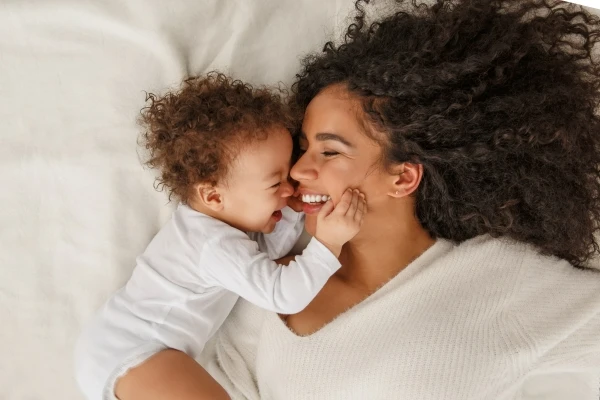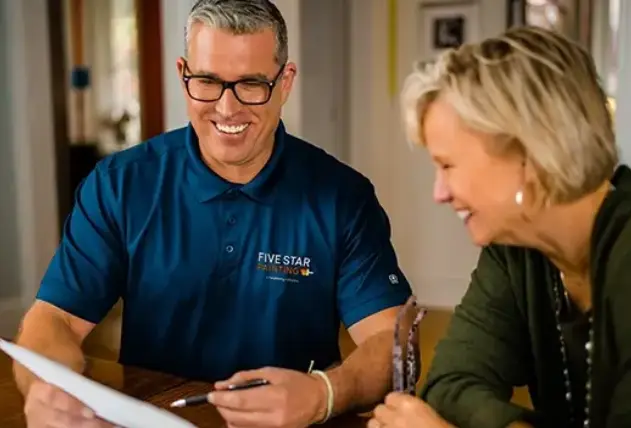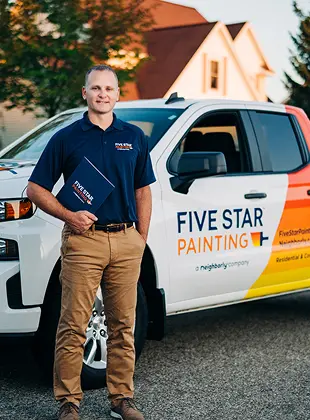
Five Star Painting explains how to choose safe paint for babies’ rooms.
|
You want to paint a room, and you now have a baby in the house. Paint produces fumes that can’t be safe for your new bundle of joy, right? It depends.
Modern paints that are non-toxic (i.e., no silicates or lead), non-odor, and no-VOC are safest to use around babies. But that doesn’t mean there is no threat to your baby. Know the right painting processes and health information before you start your project.
Are Paint Fumes Harmful to Babies?
If you choose a paint that’s considered baby-safe, fumes shouldn’t be a big problem in terms of severe or lasting health issues. However, your baby’s lungs aren’t as developed as yours, so there still could be side effects if they’re exposed to rooms where paint is still drying:
- Headaches and dizziness.
- Irritation to the eyes and respiratory system.
- Vision issues.
- Nausea.
- Rashes or other skin irritations.
So, if you are painting a space for your baby, be sure to select a paint with low or no VOCs. Sherwin Williams, which is the primary paint used by Five Star Painting, has a wide range of paints that have low or zero VOCs.
Related Topic: What Are VOCs and Where Do They Come From?
How Long After Painting Is It Safe for a Baby to Be in the Room?
If you used modern, zero-VOC paint that’s safe for babies, the room should be baby-safe within a few hours. However, there’s always a chance that your baby might be more susceptible to some of the previously mentioned effects, so waiting 48 hours is a safer choice. This is especially important if your child will be sleeping in the room.
Can a Baby Sleep in a Freshly Painted Room?
Even though your baby or toddler can be in a room within a few hours of painting, sleeping is another matter. It’s not safe to let your baby sleep in a freshly painted room until a few days have passed. This is because paint fume exposure side effects, such as respiratory issues or nausea, aren’t easily detectable when a child is asleep.
Related Topic: Protective Measures while Painting
Lead-Based Paint and Babies
If you have an older home (built prior to 1978), there is a very real chance that your home has lead-based paint. So you’re likely looking into covering or removing it before your baby needs to sleep in your house. Although lead-based paint will be hard to remove, you can paint over it using a process called encapsulation. Since special paints and techniques are required for this process, the job should be left to professionals.
Our Professionals Paint Safely
To make sure the proper paint and safety precautions are employed for your next painting project, contact Five Star Painting. We can help you choose nursery-safe paint and complete the project for you with minimal disruption. We’ll make sure your home looks good and is safe for you and your baby. To get started schedule your estimate online today or give us a call.
This article is intended for general informational purposes only and may not be applicable to every situation. You are responsible for determining the proper course of action for your home and property. Five Star Painting is not responsible for any damages that occur as a result of this blog content or your actions. For the most accurate guidance, contact the Five Star Painting location nearest you for a comprehensive, on-site assessment.
FAQs About Safe Paint for Babies
Our years of experience, attention to detail, and decades-long commitment to exceptional customer service set Five Star Painting apart from the competition. Continuing this high standard also includes using our knowledge and experience to answer your most frequently asked questions about paint safe for infants.
What’s the safest paint to use in a nursery?
When preparing a nursery, seek out paints with certifications like GREENGUARD Gold, which indicates they meet strict standards for low chemical emissions. Choosing the safest paint for your nursery is an essential part of prioritizing your baby's health.
Here's a list of types of newborn-safe paint:
- Zero-VOC (Volatile Organic Compounds) paints: VOCs are chemicals that evaporate from paint and can be harmful. Opt for paints labeled “zero-VOC” to minimize exposure.
- Low-VOC paints: While not entirely VOC-free, these paints contain significantly lower levels of harmful chemicals. They're a good alternative if zero-VOC options are limited.
- Water-based paints: These paints are generally safer than oil-based paints, as they release fewer harmful fumes. They also make cleanup easier.
- Natural paints: Consider paints made from natural materials like milk paint or clay paint. These options are free of harsh chemicals and often biodegradable.
How can I get rid of paint smells faster?
That lingering paint smell can be overwhelming, especially in a nursery with paint fumes and a baby. Here are some methods to clear the air faster:
- Ventilation: Open all windows and doors to create cross-ventilation. Use fans to circulate fresh air and direct fumes outside.
- Activated charcoal: Place bowls of activated charcoal around the room. Charcoal absorbs odors effectively. Replace it every few days.
- Baking soda: Similar to charcoal, baking soda neutralizes odors. Scatter bowls of baking soda throughout the room.
- Onions or vinegar: While they have strong odors themselves, sliced onions or bowls of white vinegar can absorb paint fumes. Place them strategically around the room.
- Coffee grounds: Fresh or used coffee grounds can also absorb odors. Place bowls of them in the room.
- Air purifiers: Use an air purifier with a HEPA filter and activated carbon filter to remove airborne particles and odors.
- Houseplants: Certain houseplants, like spider plants and snake plants, can help purify the air.
- Increase temperature: Slightly raising the room's temperature can help accelerate the evaporation of Volatile Organic Compounds (VOCs). Ensure adequate ventilation while doing this.
- Wash surfaces: Wipe down any painted surfaces with a mixture of water and vinegar.
- Time: Ultimately, time is the greatest factor in getting rid of paint smells. Even with the above methods in use, the smell will eventually dissipate naturally.
Is it safe to paint while pregnant?
Painting during pregnancy raises concerns due to potential exposure to harmful chemicals. While occasional painting in a well-ventilated area is often considered low-risk, precautions are essential. In general, if you use a paint that is safe for infants, you should be able to paint while pregnant.
Risks of painting while pregnant:
- Exposure to Volatile Organic Compounds (VOCs) in some paints can be harmful.
- Older homes may contain lead-based paint.
- Prolonged exposure, especially in poorly ventilated areas, increases risks.
Tips for safe painting while pregnant:
- Choose safe paints: Opt for zero-VOC (or low-VOC), water-based, newborn-safe paints.
- Ensure ventilation: Open windows and doors and use fans to circulate fresh air.
- Wear protection: Use a respirator mask, gloves, and protective clothing.
- Avoid old paint: Do not sand or scrape old paint, as it may contain lead.
- Limit exposure: Take frequent breaks and avoid prolonged painting sessions.
- Delegate when possible: If feasible, have someone else do the painting.
- Avoid certain chemicals: Carefully read the labels on paint cans. Avoid paints with chemicals such as ethylene glycol ethers and biocides.
- Prioritize timing: If you must paint, consider doing so in the second trimester, when organ development is less sensitive.
- Clean up carefully: Wash hands thoroughly and ventilate the area after painting.
- Consult your doctor: Discuss any concerns with your healthcare provider.
By taking these precautions, you can minimize potential risks involving paint fumes and the baby and create a safer environment.


